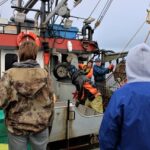Category Archives: Inland Fisheries

Efforts underway to streamline fisheries disaster relief
With an increasing number of fisheries disaster requests coming from all over the United States, members of Congress and the federal government are looking for ways to improve the relief process.,, Summer 2018 brought disappointing results for many fishermen across Alaska,,, The slow process isn’t unique to Alaska. ways to improve the relief process, introduced Senate Bill 2346 by Sen. Roger Wicker, R-Miss., in July, seeks to speed up that process, in part by expediting relief funds being disbursed to fishermen. It also seeks to add avenues for relief for non-commercial fishermen, including charter operators. >click to read< 15:00

U.S. Senate’s proposed $14 million funding increase to fight Asian carp not matched in House budget
Last month, the Senate Committee on Appropriations approved a funding bill that included $25 million for Asian carp management, a $14 million increase from last year. That money would go to the U.S. Fish and Wildlife Service to be divided nationally for areas dealing with the fish. At the time, U.S. Sen. Lamar Alexander, R-Tenn., was hopeful the bill would give areas including Tennessee more resources to deal with the threat.,, The funding increase would be used to expand a block and tackle plan. The plan includes installing sound barriers that would keep carp from traveling through dams and then paying commercial fishermen to harvest the fish. >click to read< 19:26

‘Worse now than it’s ever been’: Wheatley, Ont. harbour not safe, says fisherman
“This has been going on since the ’70s,” said Bobby Cabral, who took over his father’s business and has been fishing out of Wheatley Harbour since 1998. “It’s worse now than it’s ever been.” Cabral battles his fishing vessel in and out of the harbour on an almost-daily basis, fighting over a sandbar which keeps building up in his path. He’s one of about 35 commercial fishing vessels operating out of the harbour — vessels which bring about $9.7 million in annual landings. >click to read< 16:16

Bill to ban catching perch for profit has Saginaw Bay fishing company worried
Despite the sunny skies and the good catch, a shadow hangs over the boat. A trio of bills in the state House would, in part, stop commercial fishing of yellow perch and impose stricter regulations on commercial fishing. That worries Lakon Williams, whose family operates Bay Port Fish Co., which is based on the western shore of the Thumb, about 40 miles northeast of Bay City. “It would take away a fishery that we’ve had rights to since the 1800s, the yellow perch fishery. It’s always been a commercial fish in Saginaw Bay for us, it’s never been taken away,” she said. Video, 50 photo’s. >click to read< 15:16
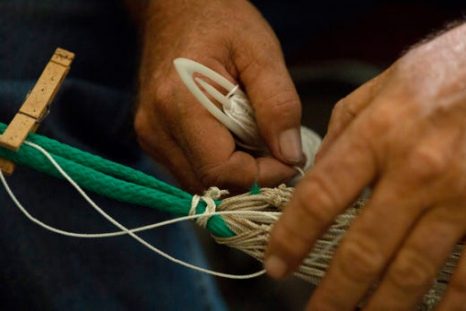
Making a living from the river: Net maker keeps craft alive as fishing culture on Southern Indiana’s White River changes
The White River has provided a source of food and livelihood for generations of Southwestern Indiana residents such as Petersburg, Indiana, resident Larry Haycraft. However, encroaching invasive species, pollution, changing lifestyles and bureaucracy – byproducts of modern living – are changing the river and its role in the community. Haycraft is keeping the craft of traditional net making alive even as inland commercial fishing is in decline in Southern Indiana.”I’m a fourth-generation master net maker,”Haycraft said. “There are very few of us left.” >click to read< 11:25

Erie man last commercial fisherman in Monroe County
It hasn’t been an easy summer for Dave Blair. The Erie native — who has long been the only continuously active commercial fisherman in Monroe County — says he was way off of his typical catch rates this year due to the higher-than-normal water levels of Lake Erie. Blair also blamed the runoff from area farms, which he says contributed to a bad spawn. “We did alright with certain species, but our main species of carp and buffalo we didn’t do nothing on them,” Blair said. This is just the latest hurdle Blair has had to overcome. >click to read< 15:07
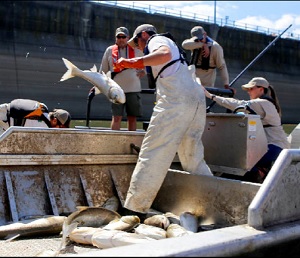
Here in Kentucky, sport fishing is gone. Kentucky, Tennessee in fight against Asian carp
Here in Kentucky, sport fishing is gone. The groups that historically flocked to the lakes for vacation have dwindled. On Aug. 1, the Kentucky Department of Natural Resources, Tennessee Wildlife Resources Agency and Tennessee Valley Authority met at the lock and dam to put on a demonstration to show the vast number of carp congregating. It was the second such demonstration that week. The groups took electrofishing boats onto the lake to stun the fish. One of the four species of Asian carp, silver carp, leap when frightened. The other three largely stay under the surface. Video. photo’s >click to read<14:00

Asian Carp Crisis: Sen. Blackburn meets with fishermen in Henry County
Local fishermen and government agencies met at North American Caviar Inc. in Henry County Friday morning to discuss solutions to a looming crisis. “Before the carp, no, I’ve never seen anything like this,” said local commercial fisherman Neil Matlock. For small businesses like North American Caviar, harvesting carp isn’t as lucrative. Local fishermen agreed that they need more help from the state if they want to expand capacity and catch more carp. >click to read< 09:45

Elsie J. – A 1945 Great Lakes fishing tug gets a new life as a tour boat in Michigan
After Chris Jensen returned home to South Haven, Mich., from World War II with a broken back, he was told he might never walk again, let alone resume his commercial fishing career. But Jensen recovered and soon bought a 48-foot fishing tug that plied the waters of eastern Lake Michigan for more than three decades. He named the boat Elsie J for his daughter. The ship’s crew pulled in loads of whitefish, perch and oily chubs, which were popular for smoking. >click to read< 10:59

Kentucky – Local government leaders and business owners say ‘War on Carp’ is working
For the past several years Asian carp have plagued Lake Barkley and Kentucky Lake. That’s why about a year ago, the War on Carp initiative was started. Its goal is to get rid of as many Asian carp as possible. Asian carp harm native species and jump out of the water — sometimes hitting boaters. “I think we’re winning the war on these fish,” says Kuttawa Marina owner Wayne Breedlove. Breedlove has seen tourism on Lake Barkley struggle as Asian carp became a problem. He says the carp problem has affected business. >click to read< 15:58

Fewer fish, or fishy science? Commercial fishers, biologists at odds over the state of Lake Winnipeg’s walleye
Minutes before dawn, five boats speed out of Hecla Village Harbour on Lake Winnipeg, home to the second-largest freshwater fishery in North America after the Great Lakes. The seven-metre skiffs are small enough to allow gill nets to be hauled up over their bows and pulled along their gunwales, revealing the catch ensnared below the surface of the shallow but enormous lake during the previous 24 hours.,, Walleye is the lifeblood of their business,,, Walleye deteriorating, province says,,, Few fish, or fishy data? >click to read< 09:14

REWARD! Wanted! Dead or Alive! $100 Bounty for Black Carp Caught in Indiana
Illinois’ Department of Natural Resources (DNR) is offering fishermen $100 for every black carp caught in Indiana, according to a web page posted Tuesday from Indiana’s DNR. Black carp are a breed of fish native to eastern Asia and populated the U.S. in the 1970–1980s. The fish are a serious threat to the surrounding wildlife in the area, including Indiana’s mussel populations. >click to read< 11:44
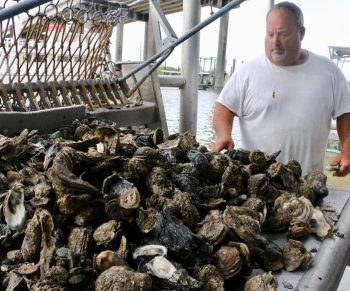
Katrina, BP, 2019 Mississippi River — Oyster Industry Braces For Another Major Disaster
The commercial fishing industry on the Gulf Coast has seen two major disasters in the last 15 years: Hurricane Katrina and the BP oil spill. Now, some fear we’re on the cusp of a third. The culprit: historic flooding from the Mississippi River. Commercial oysterman Mitch Jurisich is picking through a pile of freshly harvested oysters at a dock in Empire, Louisiana. One hand clutches an oyster knife, the other grabs a bivalve from the top of the mound. “This one’s good right here,” he says before tossing it aside and picking up another. “This one’s not good.” Audio, >click to read< 20:28

I’m a 7th-generation Michigan commercial fisherman. 13 are left.
I am a seventh generation commercial fisherman on Lake Michigan. Our family has been fishing Michigan waters since 1826, since before Michigan was a state.,,, My Great, Great Grandfather Schyuler was one of the great pioneer fishermen and owned all of what is now J.W. Wells State Park in the Upper Peninsula. At one time back in the 1980’s our company, Ruleau Bros., employed over 100 people and produced over 50 million pounds of fish. We have about 15 employees today, due to continuing over-regulation by the DNR, invasive species, and down to having only one fish left to take … the whitefish. >click to read< 10:54

Little attention has been paid to grass carp, a gluttonous herbivore that could decimate Great Lakes wetlands
Chicago has long been characterized as the last line of defense in the war to prevent bighead and silver carp from reaching the Great Lakes. But as efforts ramp up, another little-discussed species of Asian carp is already spawning in the region and could become the first to be established. Illinois and the U.S. Army Corps of Engineers have moved closer to constructing a channel,,, Unlike silver and bighead carp that scientists say would compete directly with Great Lakes fish for food, grass carp eat vegetation that provides vital habitat for the region’s waterfowl,,, Some Great Lakes states — Illinois, Indiana, Ohio, Pennsylvania and New York — still allow grass carp to be imported, Video>click to read<11:11

Floods in Midwest take toll on seafood in Gulf Coast area
Mississippi Gov. Phil Bryant and Louisiana Gov. John Bel Edwards have asked the federal government for a fisheries disaster declaration,,, Louisiana’s oyster harvest is 80% below average,,, “We’ve been dealing with the river since October,” said Acy J. Cooper Jr., president of the Louisiana Shrimp Association “That’s a long time it’s been high.” The die-offs are as bad in Mississippi.,, Shrimp are now in places only larger boats can reach, said Cooper. “Some of the big ones are catching a few,” he said. “The smaller boats are just catching hell.” >Video, click to read< 18:05

Gov. Edwards Requests Federal Declaration of a Fisheries Disaster in Louisiana
Gov. John Bel Edwards announced today that he has requested a federal fisheries disaster declaration for Louisiana from the U.S. Department of Commerce following impacts of the spring flood flight on the fishing industry in Louisiana. Troubling mortality rates among oysters, declining fish catches and the financial damage to the livelihoods of those in the fishing industry caused by floodwaters rushing from the Bonnet Carré Spillway were among the reasons for the request, which Gov. Edwards outlined in a letter to Wilbur Ross, Secretary of the U.S. Department of Commerce. >click to read<16:18

Updated – Letter: Gulf Seafood industry hampered by spillway opening
Gulf seafood harvesters need federal disaster recovery funding to ease the suffering caused by the opening of the Bonnet Carre Spillway.,, In a letter to the U.S. secretary of commerce, Mississippi Gov. Phil Bryant stated that 70% of the Mississippi Sound’s already imperiled oyster population is estimated to be dead, with the crab catch down by 35%. Shrimp season in Mississippi, which usually begins in June, will also be affected. >click to read<14:36
Gov. Edwards Requests Federal Disaster Declaration for Flooded Fisheries – >click to read<
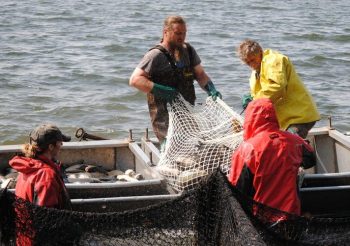
A big haul on Big Kandi
Jason George has a simple formula for improving water quality in Minnesota lakes: Take out the carp. George is hoping to remove 100,000 pounds or more under a special permit that is allowing his firm—Mike’s Rough Fish of Waterville, Minnesota—to harvest the fish.,,As of Wednesday, George was still waiting for the carp to spawn, which would make them more vulnerable to netting. They’re running a few weeks behind schedule due to the slow warm-up, he said. >Video, click to read< 08:37
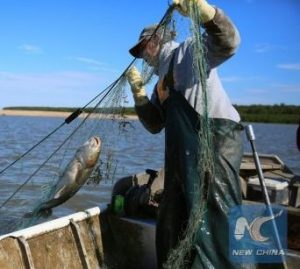
‘War on Carp’ – U.S. Sen. Mitch McConnell’s message is help is on the way
McConnell said the focus of the interested parties is catching the Asian carp, marketing the fish and reducing the population so they no longer threaten bass fishing and tourism.,,, Marshall County Commissioner Kevin Spraggs, spearheading the Marshall County War on Asian Carp Working Group, said overall the information presented during the hour-long meeting was “very promising.” “I’m very, very encouraged today. We have the right people, the right experts working on it and there’s talk of subsidies to help get more commercial fishermen involved and Senator McConnell is aggressively working on funding,” he said. >click to read<

Army Corps approves $778M plan to block Asian carp advance
The head of the Army Corps of Engineers has sent Congress a $778 million plan to fortify an Illinois waterway with noisemakers, electric cables and other devices in the hope that they will prevent Asian carp from reaching the Great Lakes, where the aggressive invaders could leave other fish with too little to eat. The plan represents a compromise between proposals to erect barriers that would seal off Lake Michigan from the river and less drastic measures such as stepped-up commercial fishing.>click to read<09:14

How an invasive species or pig hide could solve Maine’s lobster bait crisis
Gulf of Maine lobstermen are casting around far and wide for new kinds of bait now that federal regulators have cut herring quotas by 70 percent. Possible solutions range from the mass importation of a nuisance fish from the Midwest, to manufactured baits, to pig hides. Fisheries managers estimate a 50-million pound “herring gap” in Maine over the next year. To help close it, they are turning to colleagues in Illinois. >click to read<09:33
From Carp to Pig-Hide: Bait Shortage Means Change for Lobsters’ Diet – (a lot more information in this article) >click to read<

Luciano: Could Asian carp help a desperate Maine lobster market?
Officials in Illinois and Maine hope to soon announce a breakthrough that in both states could help solve aquatic challenges and boost economics. The news could especially bring a boon to central Illinois. In Illinois, invasive Asian carp choke the Illinois River. In Maine, the lobster industry faces a crisis for a sudden lack of lobster bait. If all goes well, commercial fishers in Illinois soon could be harvesting and shipping tons of Asian carp to Maine. >click to read<

Invasive mussels challenge commercial whitefish fishing in the Great Lakes
Denise Purvis’ family began fishing the waters of northern Lake Huron off Manitoulin Island in 1882. Over the years their operation came to expect the unpredictability of a livelihood dependent on the ability to capture wild fish. Purvis came back to the family business in the mid-1990s after college. Her return home coincided with the arrival of zebra and quagga mussels into the Great Lakes. The mussels have since become synonymous with the problem of invasive species in the Great Lakes. They’ve colonized the lakes and negatively impacted their ecology. For Purvis and the dwindling number of Great Lakes commercial whitefish fishers, the fishery has fallen on hard times. >Video, photo’s click to read<10:28

Asian carp lure Chinese investors (and Commercial Fishermen) to Kentucky
Justin Irwin and James Berry took turns to steer their boat on Barkley Lake in western Kentucky, looking for Asian carp.,,, Berry and Irwin, half-brothers originally from Washington, came to Kentucky to fish for Asian carp in November. Irwin is a commercial fisherman who has worked all over the world, most recently in Alaska during the summer. For three months, he worked 20 – to 22-hour days in Alaskan waters.,,, One day, Irwin read an internet article about Asian carp and commercial fishing in Kentucky, and immediately became interested. “As a commercial fisherman, I aim to fish as much as I can,” he said. >click to read<12:42

Canada closer to allowing Asian carp as lobster bait, depending on test outcomes
The Canadian Food Inspection Agency says it is prepared to accept invasive Asian carp from the United States as bait for the lobster industry, provided U.S. authorities can meet a number of conditions including proof the carcasses pose no disease threat. “If the U.S. can meet these requirements, Canada is willing to accept the import of dead, eviscerated silver carp for use as bait,” CFIA spokesperson Brian Naud said in a statement. There is interest in both countries in using Asian carp to supply their respective lobster fisheries which are experiencing a bait shortage as traditional sources decline: herring in the United States and mackerel in Canada. The state of Maine is poised to make a decision on Asian carp as a bait source by the end of May. >click to read<11:34

Spotlight: First Asian carp industrial park in U.S. heralds triumph over invasive fish
The birth of an industrial park devoted to Asian carp processing in the southeastern U.S. state of Kentucky has added to hopes that its prowess in turning the bony fish into delicacy increases the odds of winning the battle against the invasive fish in the Mississippi River. On April 12, the International Fisheries Industrial Park, sitting on 64 acres of wooded land in Wickliffe City, Ballard County, came online. With the newly arrived Chinese makers of fish ball, smoked fish, dried fish, fish sauce and a manufacturer who turns fish guts into organic fertilizers, the industrial park achieves vertical processing integration and is waste-free. (a possible new lobster bait source!) >click to read<13:59

Canada says no to Asian carp as lobster bait
The Canadian Food Inspection Agency is throwing cold water on the prospect of importing Asian carp from the United States for use as lobster bait.
With bait prices on the rise, the invasive species was promoted as a cheaper bait source for the lucrative fishery. “The CFIA is aware that the industry has expressed interest in importing Asian carp for bait for the lobster fishery,” agency spokesperson Christine Carnaffan said in an email. The position is news to promoter Patrick Swim of lobster.ca, who said he has spent months seeking permits from both countries to import Asian carp from the Illinois River as bait for the lobster fishery in southwest Nova Scotia and Maine. >click to read<08:46

Commercial fishing of Asian carp is catching on in the Heartland
Investors behind the creation of the ‘International Fisheries Industrial Park’ in Wickliffe, Kentucky unveiled their plans at an event at Two Rivers Fisheries on Friday, April 12. The property already has three fisheries and seven new investors are now on board to develop zero-waste facilities dedicated to harvesting the troublesome fish. Dr. He is the Development Manager for Two Rivers and the new industrial park. Over the last seven years, the fishery has harvested more than 10 million pounds of Asian carp from bodies of water in the Heartland. Dr. He says creating even more demand for the fish can be a win-win situation. >click to read<10:35

Lake Erie walleye quotas up but ‘devastating’ drop for perch, says commercial fishery
The allowable catch limit for yellow perch in Lake Erie has dropped by as much as 32 per cent for the part of the lake near Chatham-Kent, Tim Tiessen, president of the Ontario Commercial Fisheries’ Association, said Monday. The quota is dropping by about 20 per cent for commercial fishing boats operating south of Essex County.,,, “That’s going to be hard for the fisherman,” On the plus side, the quota for walleye is going up about 20 per cent across Lake Erie. The binational Lake Erie Committee of fishery managers from Michigan, New York, Ohio, Pennsylvania and Ontario recently decided the total allowable catch limits,,, >click to read<16:43










































